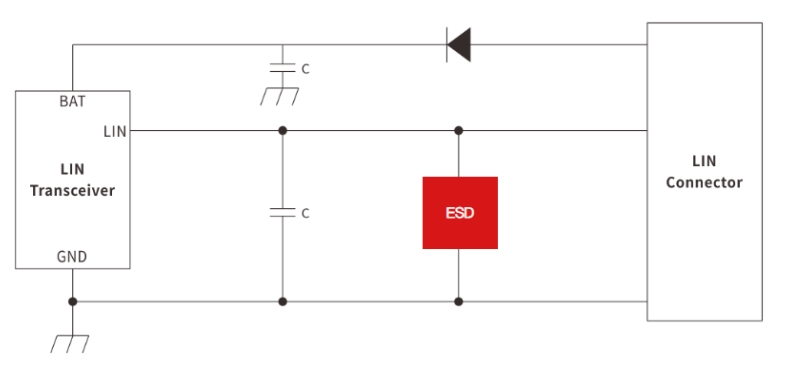🌏Overview
The LIN (Local Interconnect Network) bus is a low-cost, simple, and highly reliable serial communication protocol using a single-wire implementation. It is primarily used for communication between low-speed devices in automotive electronic systems, such as power window controls, electric seats, air conditioning units, and wiper modules. These modules are often susceptible to electrostatic threats and electromagnetic interference caused by inductive load switching.
⚡Static Electricity Issues Faced by the LIN Bus
Because LIN uses a single-wire communication structure and is widely used in modules exposed to the external environment, such as doors, rearview mirrors, and lights, it is susceptible to the following static electricity threats:
1.ESD (Electrostatic Discharge)
- Main Sources: Human contact, connector plugging and unplugging, and discharge during manufacturing/repair.
- Characteristics: High voltage (typically > 2kV), short, high-energy pulses.
- Consequences: May cause communication errors, receiver damage, and master/slave node chip failure.
2.Electrical Fast Transients (EFT)
- Main Source: Electromagnetic interference caused by relays or switching inductive loads.
📌LIN Bus Anti-Static Protection Requirements
- Meet ISO 10605 or IEC 61000-4-2 electrostatic test standards (±8kV contact discharge, ±15kV air discharge).
- Guarantee that the LIN transceiver is not damaged by ESD/EFT.
- Do not affect normal communication (this means the protection device must have low capacitance and fast response).
⚡Semiware's Electrostatic Protection Block Diagram

📌Circuit Design and Protection Devices
1.Key Design Points:
- The device should be connected in parallel between the LIN signal line and ground.
- The operating voltage must be higher than the normal LIN communication voltage (typically, the LIN level range in a 12V system is 0-18V).
- Place the protection device as close as possible to the LIN interface.
- For automotive applications, electrostatic discharge (ESD) protection is a key consideration for the LIN bus.
- ESD protection devices must balance protection capabilities with communication compatibility (low capacitance and low leakage).
- When selecting a device, consider key parameters such as ESD level, voltage, and capacitance. Those that meet automotive standards are more reliable.
2.Circuit Protection Devices
We recommend the Semiware‘s ESD1LIN">PESD1LIN ESD protection diode, which is designed specifically for the LIN bus and offers automotive-grade reliability and excellent ESD protection.
➡️Typical Features
- Designed specifically for the LIN bus: Supports the voltage and protocol requirements for LIN communication in 12V automotive systems
- High ESD withstand capability: Far exceeds IEC standards, ensuring long-term stable vehicle operation
- Small package accommodates high-density layouts: The SOT23 package saves PCB space
- Fast response speed: Responds to electrostatic discharges in nanoseconds
- Low leakage current and low capacitance: Does not affect normal bus communication performance
❓FAQ
- Why can't ordinary TVS diodes be used for the LIN bus?
Ordinary TVS diodes have too high capacitance, which can interfere with LIN signals and cause communication errors. The ESD1LIN">PESD1LIN is specifically designed for LIN and has a lower capacitance (13pF). It provides strong ESD protection without compromising signal integrity. - What are the key PCB layout requirements for the ESD1LIN">PESD1LIN?
The core requirement is "proximity." It must be placed as close to the LIN interface as possible, and a short, thick ground wire must be used to provide the shortest possible discharge path for static electricity to ensure effective protection. - Does it protect against power surges?
No. The ESD1LIN">PESD1LIN primarily protects against fast transients like ESD. For power surges (such as load dump), a dedicated power surge protection device must be used separately on the power line. - How can I confirm that my design can pass automotive ESD testing?
Ultimately, laboratory certification testing is required. During design, we ensured that the PESD1LIN's parameters (such as ±15kV ESD) exceeded standards (such as ISO 10605) and verified this with an electrostatic gun during the prototype phase. - Does Semiware offer other automotive bus protection products?
Yes. Semiware offers a full range of automotive-grade protection devices, such as the PESD1CAN and PESD2CAN for CAN buses and ESD protectors for high-speed data ports, all meeting AEC-Q101 reliability standards. - Is Semiware’s ESD1LIN equivalent to Nexperia">PESD1LIN equivalent to Nexperia PESD1LIN?
Yes, Semiware PESD1LIN is fully compatible with Nexperia PESD1LIN in terms of specifications, performance, and applications.
🔌Related Products
PESD1CAN:https://en.semiware.com/automotive-esd/pesd1can/
PESD2CAN:https://en.semiware.com/automotive-esd/pesd2can/
📩Request a quote for PESD1LIN or related products,please contact us⬇️
Sales29@semiware.com


Comments (0)